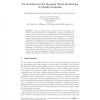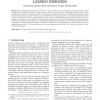64 search results - page 9 / 13 » Collaborative Anomaly-Based Attack Detection |
NDSS
2006
IEEE
14 years 1 months ago
2006
IEEE
Software monocultures are usually considered dangerous because their size and uniformity represent the potential for costly and widespread damage. The emerging concept of collabor...
OTM
2009
Springer
14 years 1 months ago
2009
Springer
Collusion attacks remain a major problem of reputation and trust models, in mobile ad hoc networks. By covering up malicious behaviour of one another from the remaining part of the...
TMC
2011
13 years 2 months ago
2011
—We investigate location distinction, the ability of a receiver to determine when a transmitter has changed location, which has application for energy conservation in wireless se...
WISE
2010
Springer
13 years 4 months ago
2010
Springer
Abstract. Association rule mining algorithms such as Apriori were originally developed to automatically detect patterns in sales transactions and were later on also successfully ap...
SRDS
2007
IEEE
14 years 1 months ago
2007
IEEE
Sensors that operate in an unattended, harsh or hostile environment are vulnerable to compromises because their low costs preclude the use of expensive tamper-resistant hardware. ...


